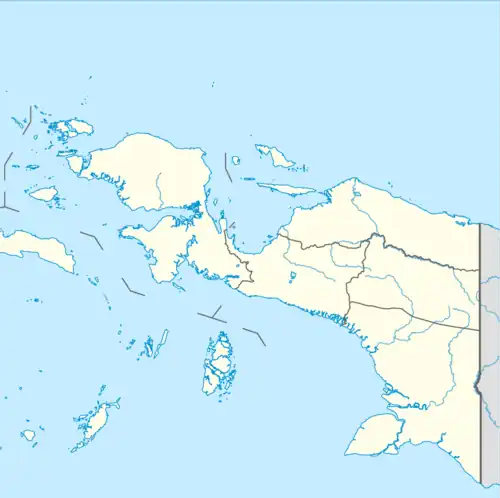  | |
| UTC time | 2004-02-05 21:05:02 |
|---|---|
| ISC event | 7248018 |
| USGS-ANSS | ComCat |
| Local date | 2004-02-06 |
| Local time | 06.05 WIT |
| Magnitude | 7.0 Mw, 7.3 Mw [1] |
| Depth | 23 km (14 mi) [1] |
| Epicenter | 3°38′35″S 135°31′26″E / 3.643°S 135.524°E [1] |
| Type | Oblique-normal |
| Areas affected | Central Papua |
| Max. intensity | VI (Strong) |
| Casualties | 37 dead, 682 injured |
The February 2004 Nabire earthquakes began on February 6 at 06.05 WIT in Nabire Regency, Central Papua (then Papua), Indonesia. The first of three large earthquakes measured 7.0 on the moment magnitude scale (Mw ). It was followed a few days later by two strong shocks, measuring Mw 7.3 and 6.7, respectively. The earthquakes were felt at Nabire with a maximum Mercalli intensity of VI (Strong).[2] At least 37 people were killed and were 682 injured, and over 2,600 buildings were damaged or destroyed.
Tectonic setting
Eastern Indonesia is broadly characterized by complex tectonics in which motions of numerous small microplates are accommodating large-scale convergence between the Australian, Pacific, Philippine Sea, and Sunda plates. The interactions of these microplates produce all possible faulting mechanisms. The region is seismically active—a magnitude 7.9 earthquake in 1979 was among the strongest ever recorded.[3]
Earthquakes
According to the United States Geological Survey, the February 5 earthquake was the result of shallow oblique normal faulting on or near a transform fault. A focal mechanism of the event indicate it occurred on either a near-vertical right-lateral strike-slip fault trending southeast-northwest, or on a shallower left-lateral fault striking towards the northeast, parallel to the regional plate boundary. The February 7 earthquake was the result of shallow strike-slip faulting in approximately the same fault area. Rupture during the second earthquake occurred on either a left-lateral east-west oriented fault or a right-lateral fault trending north-south.[3]
The earthquakes struck along the transform fault boundary which separates the Birds Head and the Maoke plates. The east-northeast trending boundary accommodates approximately 80 mm (3.1 in)/yr of left-lateral motion. While the February 7 earthquake slightly oblique to this orientation, the east-west plane of its focal mechanism is more consistent with motion along this plate boundary.[3]
Impact
The initial earthquake on February 5 caused 37 fatalities and left 682 injured. Around the epicenter area, at least 2,678 structures were damaged or destroyed, including nine bridges. An official said that many people died due to collapsing homes.[4] In Nabire, the airport runway was damaged and power outages were reported.[2] The walls of many buildings toppled, including those of homes, places of worship, and offices. Telecommunication services were interrupted. Downtown Nabrie was extensively damaged; a hospital, the court building, and many shophouses were destroyed. Some residential areas and a local market caught fire.[4] Bridges collapsed, roads cracked, and many trees fell. A leak was discovered at a Pertamina oil refinery.[5] There were no casualties reported from the larger earthquake on February 7 despite that being anticipated.[6]
Aftermath
Earlier reports indicated that 22 people had died and over 100 were injured, but officials said the casualty numbers were expected to rise.[7] The injured were taken to various hospitals, including one who was transported to Surabaya. Two victims died while being treated. The Biak Numfor Regency government said that they were ready to assist the affected people.[8] The first aircraft carrying relief supplies arrived at Nabire airport on February 9. Some victims were treated at the Nabire Hospital, which sustained damage. Survivors took refuge in tents outside their homes for fear of aftershocks.[4] The Indonesian Red Cross provided assistance to medical professionals in the area. A medical team from Jayapura was expected to arrive on February 10.[9] The Australian government provided AU $50 thousand to the International Federation of the Red Cross for relief supplies such as personal hygiene kits, tents, tarpaulins and blankets. It also said that should the Indonesian government request for assistance, it would provide assistance.[10]
See also
References
- 1 2 3 ISC (2016), ISC-GEM Global Instrumental Earthquake Catalogue (1900–2012), Version 3.0, International Seismological Centre
- 1 2 National Geophysical Data Center / World Data Service (NGDC/WDS) (1972), Significant Earthquake Database (Data Set), National Geophysical Data Center, NOAA, doi:10.7289/V5TD9V7K
- 1 2 3 Hayes, Gavin P.; Meyers, Emma K.; Dewey, James W.; Briggs, Richard W.; Earle, Paul S.; Benz, Harley M.; Smoczyk, Gregory M.; Flamme, Hanna E.; Barnhart, William D.; Gold, Ryan D.; Furlong, Kevin P. (2017). "Tectonic summaries of magnitude 7 and greater earthquakes from 2000 to 2015". Open-File Report (Report). Open-File Report. U.S. Geological Survey. p. 148. doi:10.3133/ofr20161192.
 This article incorporates text from this source, which is in the public domain.
This article incorporates text from this source, which is in the public domain. - 1 2 3 "Indonesia quake kills 23, more feared dead". Vol. 4, no. 8. The Daily Star. Reuters. 7 February 2004. Retrieved 20 August 2022.
- ↑ Levi, Cunding; Oetomo, Lita (7 February 2004). "Nabire Hancur Diguncang Gempa" [Nabire Destroyed by Earthquake]. Tempo (in Indonesian).
- ↑ "Indonesia rattled by earthquakes". Reuters. CNN. 7 February 2004. Retrieved 20 August 2022.
- ↑ "Gempa Bumi di Papua Menewaskan 22 Orang - 2004-02-06" [Earthquake in Papua Kills 22 People - 2004-02-06]. Voice of America (in Indonesian). 6 February 2004. Retrieved 20 August 2022.
- ↑ Oetomo, Lita; Levi, Cunding (8 February 2004). "Dua Gempa Susulan Terjadi di Nabire" [Two Aftershocks Occur in Nabire]. Tempo (in Indonesian).
- ↑ Kadir, Ruba`i (9 February 2004). "Hari Ini Nabire Gempa Empat Kali" (in Indonesian). Liputan 6. Retrieved 20 August 2022.
- ↑ AusAID (13 February 2004), Earthquake in the Indonesian Province of Papua (Press Release), ReliefWeb, retrieved 20 August 2022
External links
- The International Seismological Centre has a bibliography and/or authoritative data for this event.
- The International Seismological Centre has a bibliography and/or authoritative data for this event.
- Earthquake in Indonesia (Papua province)